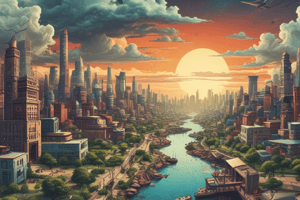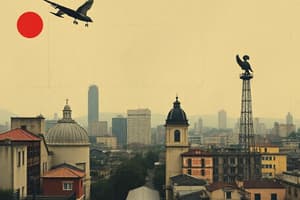Podcast
Questions and Answers
What is a primary function of subways or metros in large cities?
What is a primary function of subways or metros in large cities?
- Reducing the variety of services available
- Providing recreational activities
- Handling a significant portion of commuter traffic (correct)
- Increasing crime rates
Which of the following is NOT typically considered a benefit of urbanization?
Which of the following is NOT typically considered a benefit of urbanization?
- Higher unemployment rates (correct)
- Access to educational institutions
- Concentration of services
- Job creation
What are modern cities particularly known for in terms of workforce?
What are modern cities particularly known for in terms of workforce?
- High rates of rural employment
- Reduction of commercial innovations
- Concentration of highly educated people (correct)
- Lack of educated individuals
What factor contributed to the growth of modern cities in Europe during the 18th century?
What factor contributed to the growth of modern cities in Europe during the 18th century?
Which of the following negative effects is associated with uncontrolled urbanization?
Which of the following negative effects is associated with uncontrolled urbanization?
What is one of the negative side effects of rapid urbanization in developing nations?
What is one of the negative side effects of rapid urbanization in developing nations?
What has caused urbanization in developing countries?
What has caused urbanization in developing countries?
What is the approximate percentage of Earth's population living in cities?
What is the approximate percentage of Earth's population living in cities?
Which of the following is NOT typically associated with the conditions in slums?
Which of the following is NOT typically associated with the conditions in slums?
Which statement about urbanization in developing nations is accurate?
Which statement about urbanization in developing nations is accurate?
Which term describes cities with populations over 10 million?
Which term describes cities with populations over 10 million?
What has NOT contributed to poor living conditions in rural areas of developing nations?
What has NOT contributed to poor living conditions in rural areas of developing nations?
What phenomenon results in the connection of nearby metropolises?
What phenomenon results in the connection of nearby metropolises?
Which factor fuels the rapid rate of urbanization in developing nations?
Which factor fuels the rapid rate of urbanization in developing nations?
What is the trend for the number of megacities by the end of the 2020s?
What is the trend for the number of megacities by the end of the 2020s?
Which issue has NOT arisen due to rapid urbanization in developing countries?
Which issue has NOT arisen due to rapid urbanization in developing countries?
When did the growth of modern cities begin, according to the content?
When did the growth of modern cities begin, according to the content?
What was a primary reason for people moving from rural to urban areas historically?
What was a primary reason for people moving from rural to urban areas historically?
What impact does urbanization generally have on distances between essential services?
What impact does urbanization generally have on distances between essential services?
How has the quality of living in European cities changed over time?
How has the quality of living in European cities changed over time?
What distinguishes megalopolises from other urban areas?
What distinguishes megalopolises from other urban areas?
Flashcards
Urbanization
Urbanization
The increasing concentration of human populations in urban areas.
Megacity
Megacity
A city or metropolitan area with a population over 10 million people.
Metropolis
Metropolis
A large city with a population of over one million people.
Megalopolis
Megalopolis
Signup and view all the flashcards
Developing Nations Urbanization
Developing Nations Urbanization
Signup and view all the flashcards
Global Phenomenon
Global Phenomenon
Signup and view all the flashcards
Industrial Revolution Urbanization
Industrial Revolution Urbanization
Signup and view all the flashcards
Slum Regions
Slum Regions
Signup and view all the flashcards
Rapid Urbanization in Developing Nations
Rapid Urbanization in Developing Nations
Signup and view all the flashcards
Urban Decay
Urban Decay
Signup and view all the flashcards
Slums in Cities
Slums in Cities
Signup and view all the flashcards
Urbanization Push Factors
Urbanization Push Factors
Signup and view all the flashcards
Urbanization Pull Factors
Urbanization Pull Factors
Signup and view all the flashcards
Urbanization Benefits
Urbanization Benefits
Signup and view all the flashcards
Side Effects of Rapid Urbanization
Side Effects of Rapid Urbanization
Signup and view all the flashcards
Developing Nation Urbanization
Developing Nation Urbanization
Signup and view all the flashcards
Urbanization
Urbanization
Signup and view all the flashcards
Metropolis
Metropolis
Signup and view all the flashcards
Megalopolis
Megalopolis
Signup and view all the flashcards
Public Transportation
Public Transportation
Signup and view all the flashcards
Urban Decay
Urban Decay
Signup and view all the flashcards
Urban Unemployment
Urban Unemployment
Signup and view all the flashcards
City Services
City Services
Signup and view all the flashcards
Urbanization in 20th century
Urbanization in 20th century
Signup and view all the flashcards
Modern City Benefits
Modern City Benefits
Signup and view all the flashcards
Growth of Cities
Growth of Cities
Signup and view all the flashcards
Study Notes
Urbanization is a Global Phenomenon
- Urbanization is the process of people moving from rural areas to cities
- A large portion (half) of the global population lives in cities.
- This is especially prominent in Asian and African nations.
- People move to cities for jobs and better living conditions; however, many end up in slums.
- Cities with over a million inhabitants are called metropolises.
- Metropolises can connect to form large megalopolises.
- The BosWash region is an example of a megalopolis.
- Currently, there are over 400 metropolises worldwide.
- The number of metropolises is increasing due to rural-urban migration, specifically in developing nations.
- Megacities are metropolitan areas with over 10 million people.
- Currently, there are over 20 megacities worldwide.
- Almost one-tenth of the global population lives in these megacities.
- The number of megacities is expected to double by the year 2030.
What is Urbanization?
- Urbanization isn't solely population growth in cities but also the associated lifestyle and economic changes.
- The shift from agricultural jobs to industrial and service jobs is a key part of urbanization.
- Rural job losses drive people to urban areas for better economic opportunities.
- Urban living offers various services and more employment opportunities.
- Urban lifestyles are marked by higher levels of pedestrian and vehicle traffic.
Urban Growth in Developing Nations
- Urbanization began later in developing countries in comparison to industrialized countries, with the process mainly beginning from the 1950s.
- The speed of urbanization in developing nations was very high compared to that of industrialized nations.
- Rapid growth in developing countries leads to unmanageable urban expansion, with numerous negative impacts.
- These problems include rapid urban decay, high rates of crime, unemployment, traffic disorders, pollution, and difficulties in providing adequate sanitation.
Urban Decay
- A common effect associated with rapid urbanization in developing nations is urban decay.
- People moving to urban areas often face challenges accessing housing and employment.
- They often end up in slums on the outskirts of cities, where living conditions are extremely cramped, and access to basic necessities like electricity and clean water are limited.
- These inadequate conditions often lead to disease outbreaks and criminal activity.
Benefits of Urbanization
- Urbanization leads to dense city structures facilitating shorter distances between work, housing, and services.
- Public transportation systems (subways, metros) ease transportation between different parts of the city.
- Increased population concentrations lead to specialization of services and industries.
- Large cities are also major centers of business and commerce, as well as centers of knowledge and innovation.
Studying That Suits You
Use AI to generate personalized quizzes and flashcards to suit your learning preferences.




